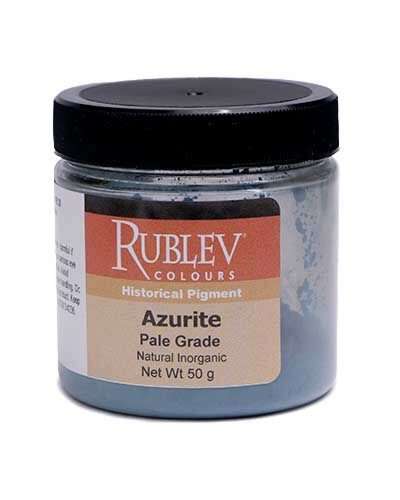Azurite (Pale) 50g
Azurite is natural carbonate of copper from ore deposits in Hunan Province, China. It has a pale blue masstone and a greenish gray undertone with a fine grind of less than 20 micron particles.
Azurite is a natural carbonate of copper usually described as a bright blue or sometimes as a greenish blue. Azurite varies in masstone color from deep blue to pale blue with a greenish undertone depending on such factors as the purity of the mineral and the grade (particle size) of the pigment. This fine grade (average 25 micron particle size) of azurite is a pale blue with a greenish gray undertone.
| Pigment Names | |||||||
| Common Names: | English: azurite French: azurite German: Azurit Italian: azzurrite Spanish: azurita | ||||||
| Synonyms: | English: blue verditer, bice, Mountain blue French: bleu de montagne, bleu d'Allemagne German: Bergblau Italian: azzurro della magna Latin: lapis armenius, azurium citramarinum | ||||||
| Nomenclature: |
| ||||||
| Pigment Information | |
| Color: | Blue |
| Pigment Classification: | Natural Inorganic |
| Colour Index: | Pigment Blue 30 (PB30) |
| Chemical Name: | Copper Carbonate |
| Chemical Formula: | Cu3(CO3)2(OH)2 |
| CAS No.: | 1319-45-5 |
| Series No.: | 7 |
| ASTM Lightfastness | |
| Acrylic: | Not Listed |
| Oil: | Not Listed |
| Watercolor: | Not Listed |
| Physical Properties | |
| Particle Size (mean): | 25 microns |
| Density: | 3.80 g/cm3 |
| Hardness: | 3.50–4.00 |
| Refractive Index: | 1.758 |
| Oil Absorption: | 25 grams oil / 100 grams pigment |
| Health and Safety | This is a natural substance that has not been evaluated for acute or chronic health hazards. Always protect yourself against potentially unknown chronic hazards of this and other chemical products by keeping them out of your body. Copper carbonate is classified as hazardous under OSHA regulations (29CFR 1910.1200) (Hazcom 2012): Acute toxicity—Oral—Category 4 Skin irritant—Category 2 Eye irritation—Category 2A Based on this information we present the following health warning: WARNING! Contains Copper Carbonate. Harmful if swallowed. Causes skin irritation. Causes serious eye irritation. Avoid ingestion, excessive skin contact, and inhalation of dusts. Conforms to ASTM D-4236. |
For a detailed explanation of the terms in the table above, please visit Composition and Permanence.
Origin and History of Use
According to some authorities, azurite has been found in paint pigment as early as the Fourth Dynasty in Egypt.
Source
Azurite is a natural carbonate of copper and is found in many parts of the world in the upper oxidized portions of copper ore deposits along with malachite. Our azurite is from copper ore deposits in Hunan Province, China.
Permanence and Compatibility
Despite azurite being a carbonate, and hence sensitive to acids, it has a good record in respect to permanence where employed in oil- and tempera media. It is darkened when exposed to sulfur fumes, especially where it is used in mural paintings. It is unaffected by light. Azurite pigment is said to turn green due to alteration to malachite. Although copper pigments tend to exert both a siccative and antioxidant effect in oil-medium, some examples have shown that azurite tends to discolor when applied in thick, coarse-textured layers.
Oil Absorption and Grinding
No data has been published on the oil absorption properties of azurite. Coarsely ground azurite produces a dark blue pigment; fine grinding produces a lighter tone. We offer a fine and medium ground pigment with an intense blue hue. Azurite is most successfully employed in aqueous medium, such as tempera, because of its refraction index.
Toxicity
Azurite is moderately toxic and care should be used in handling the dry powder pigment as well as the pigment dispersed in medium.
For more information on how to handle pigments safely, please visit How to Safely Handle Art Materials and Pigments.
| SKU | 410-1205 |
|---|---|
| Brand | Rublev Colours |
| Vendor | Natural Pigments |
| Processing Time | Usually ships the next business day. |
| Size | 50 g jar |
| Color | Blue |



